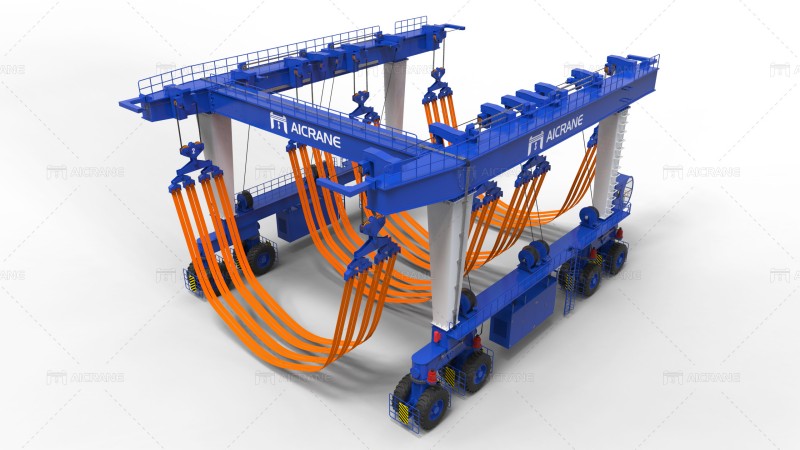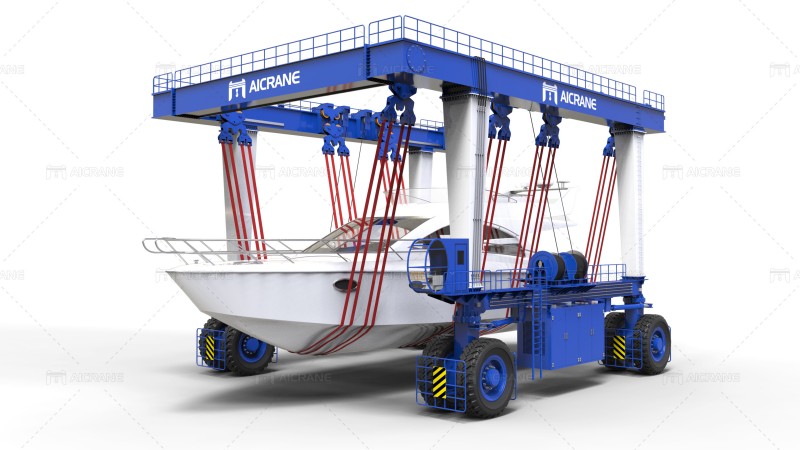In the realm of marinas and waterfront facilities, the advent of mobile boat hoists has ushered in a new era of efficiency and flexibility. No longer confined to traditional slips and fixed lifting infrastructure, these innovative machines have proven to be game-changers in the maritime industry. This article explores the mobility advantage of mobile boat hoists, shedding light on how these versatile lifting systems are transforming the way boats are handled, maintained, and launched.
Unleashing Mobility in Marina Operations
The traditional image of a boat being lifted by a fixed crane and gently placed into the water from a slip is undergoing a revolutionary transformation, thanks to mobile boat hoists. These powerful machines are designed to be on the move, providing marinas and boatyards with the flexibility to handle vessels beyond the constraints of static infrastructure.

The mobility advantage stems from the ability of these hoists to navigate the waterfront with ease. Equipped with wheels or tracks, mobile boat hoists can travel along docks, ramps, and even paved surfaces, reaching boats wherever they are located within the marina. This flexibility not only streamlines boat handling processes but also maximizes the use of available space, allowing for more efficient storage and movement of vessels.
Precision in Portability
While mobility is a key feature, mobile boat hoists don’t compromise on precision. These hoists are engineered to lift and transport boats with accuracy, ensuring that vessels are handled delicately and securely. The precision in portability is particularly valuable when dealing with a diverse range of boat sizes and types.
The lifting mechanisms of mobile boat hoists are designed to accommodate various hull shapes and weights. Whether lifting a sleek sailboat or a sturdy motor yacht, these hoists can be adjusted to provide optimal support, minimizing the risk of damage during the lifting and launching process. The marriage of precision and portability allows marinas to cater to a broad spectrum of boat owners and their unique vessel requirements.
Redefining Boat Maintenance
One of the notable advantages of mobile boat lifts is their impact on boat maintenance practices. Traditionally, maintenance tasks were often limited to boats docked in slips or housed in designated maintenance areas. Mobile hoists, however, enable marinas to bring maintenance directly to the boat, regardless of its location within the facility.
This capability is particularly advantageous for routine inspections, hull cleanings, and minor repairs. Instead of requiring boat owners to bring their vessels to a specific maintenance area, mobile boat hoists can transport boats to dedicated workspaces within the marina. This not only saves time but also enhances the overall efficiency of maintenance operations, contributing to a more streamlined and responsive service for boat owners.

Launching Freedom: The Boatyard Advantage
The mobility advantage of these hoists extends beyond marinas to boatyards and repair facilities. In boatyards, where vessels may be stored for extended periods, mobile boat hoists provide a dynamic lifting solution for launching boats back into the water. This flexibility is particularly valuable for boatyards that may have irregular layouts or limited space, allowing them to optimize their storage areas and provide a more customized and responsive service to boat owners.
Boatyards equipped with mobile hoists can efficiently move boats from storage to water and back, accommodating the ebb and flow of vessel demand. The ability to transport boats across the boatyard with precision ensures that launching is a seamless and controlled process, minimizing the risk of accidents and optimizing the overall boatyard workflow.
Environmental Considerations
The mobility advantage of mobile boat hoists not only enhances operational efficiency but also aligns with environmental considerations. Traditional methods of boat lifting and launching, such as fixed cranes and slips, often require significant infrastructure and may disturb the natural shoreline.
Mobile boat hoists, with their ability to move along existing pathways, reduce the need for extensive construction and shoreline alterations. This adaptability is especially beneficial in preserving the ecological integrity of waterfront areas, allowing marinas and boatyards to operate in harmony with their natural surroundings.
Future Innovations and Integration
As technology continues to evolve, the future of mobile boat hoists holds exciting possibilities. Integrating automation and smart technologies into these lifting systems could further enhance their efficiency and precision. Automated hoists could be programmed to navigate predefined paths, optimizing the movement of boats within the marina or boatyard.
The integration of sensors and real-time data analysis could provide valuable insights into equipment health and usage patterns, allowing for proactive maintenance and optimizing the overall lifecycle of mobile boat hoists. Such innovations would not only increase the operational capabilities of these machines but also contribute to the ongoing digitization of maritime services.
Conclusion
In the maritime world, where the tides of innovation are reshaping traditional practices, mobile boat hoists stand as beacons of progress. Beyond the slip, these versatile lifting systems are unlocking new possibilities in marina operations, boat maintenance, and boatyards. The mobility advantage they bring to the waterfront is not just a matter of convenience; it’s a paradigm shift that allows the maritime industry to adapt to the diverse needs of boat owners and the evolving demands of the modern boating landscape. As mobile boat hoists continue to roll into marinas and boatyards around the world, they carry with them the promise of a more flexible, efficient, and environmentally conscious era in boat handling and maintenance.